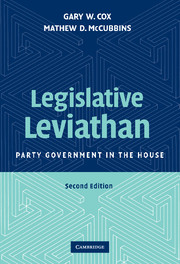Book contents
- Frontmatter
- Contents
- List of Figures
- List of Tables
- Acknowledgments
- Legislative Leviathan
- Introduction
- PART ONE THE AUTONOMY AND DISTINCTIVENESS OF COMMITTEES
- 1 Self-Selection and the Subgovernment Thesis
- 2 The Seniority System in Congress
- 3 Subgovernments and the Representativeness of Committees
- PART TWO A THEORY OF ORGANIZATION
- PART THREE PARTIES AS FLOOR-VOTING COALITIONS
- PART FOUR PARTIES AS PROCEDURAL COALITIONS
- PART FIVE PARTIES AS PROCEDURAL COALITIONS
- Conclusion
- Appendix 1 Uncompensated Seniority Violations, Eightieth through Hundredth Congresses
- Appendix 2 A Model of the Speaker's Scheduling Preferences
- Appendix 3 Unchallengeable and Challengeable Vetoes
- Appendix 4 The Scheduling Power
- Bibliography
- Author Index
- Subject Index
1 - Self-Selection and the Subgovernment Thesis
Published online by Cambridge University Press: 05 June 2012
- Frontmatter
- Contents
- List of Figures
- List of Tables
- Acknowledgments
- Legislative Leviathan
- Introduction
- PART ONE THE AUTONOMY AND DISTINCTIVENESS OF COMMITTEES
- 1 Self-Selection and the Subgovernment Thesis
- 2 The Seniority System in Congress
- 3 Subgovernments and the Representativeness of Committees
- PART TWO A THEORY OF ORGANIZATION
- PART THREE PARTIES AS FLOOR-VOTING COALITIONS
- PART FOUR PARTIES AS PROCEDURAL COALITIONS
- PART FIVE PARTIES AS PROCEDURAL COALITIONS
- Conclusion
- Appendix 1 Uncompensated Seniority Violations, Eightieth through Hundredth Congresses
- Appendix 2 A Model of the Speaker's Scheduling Preferences
- Appendix 3 Unchallengeable and Challengeable Vetoes
- Appendix 4 The Scheduling Power
- Bibliography
- Author Index
- Subject Index
Summary
Many students of American national politics have noticed the cozy arrangements between congressional committee members, executive agents, and interest group lobbyists that seem to dominate decision making in a wide range of policy arenas. These “iron triangles” or “unholy trinities,” also known by the less pejorative tag of “subgovernments,” are thought to be largely independent of presidents, party leaders, and other “outside” influences.
In the standard analysis, subgovernments stem from a set of early twentieth-century congressional reforms that redistributed power from party leaders to committee chairpersons. The most important of these reforms came with the revolt against “czar rule” in 1910 and 1911, when Progressive Republicans united with Democrats to strip the Speakership of much of its power. After a brief period during which the majority party caucus was active in determining policy, the House entered the era of “committee government,” during which “each committee was left to fashion public policy in its own jurisdiction” (Dodd and Oppenheimer 1977, 22) and party leaders acted “as agents for, rather than superiors to, committee leaders and members of the inner club” (Shepsle 1989, 246). Policy in the decentralized, postrevolt House was “incubated and crafted by interested members who monopolized the berths on committees important to their constituents' concerns.” The end result was a “gigantic institutional logroll” that “sanctified the division of labor that permitted policy making by subgovernments” (Shepsle 1989, 246–7).
- Type
- Chapter
- Information
- Legislative LeviathanParty Government in the House, pp. 17 - 42Publisher: Cambridge University PressPrint publication year: 2007



